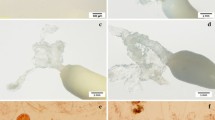Summary
Microsporophylls ofPinus resinosa and megagametophyte tissue ofPinus nigra var.austriaca andPinus mugo var.mughus were cultured on Brown and Lawrence's medium. The microsporophylls formed a mixed haploid-diploid callus, and the megagametophyte tissue a purely haploid callus. Subcultures were established of the calluses. The mode of development of haploid callus and various types of organization in the calluses are described. Chromosome stickiness occurred in old calluses.
Similar content being viewed by others
References
Bonga, J. M., and D. P. Fowler. 1970. Growth and differentiation in gametophytes ofPinus resinosa cultured in vitro. Can. J. Bot. 48: 2205–2207.
Sharp, W. R., R. S. Raskin, and H. E. Sommer. 1972. The use of nurse culture in the development of haploid clones in tomato. Planta 104: 357–361.
Brown, C. L., and R. H. Lawrence. 1968. Culture of pine callus on a defined medium. Forest Sci. 14: 62–64.
Simak, M., and C. Happel. 1966. Vorbehandlung der Koniferen Samen für Chromosomenuntersuchungen. Silvae Genet. 15: 38–41.
Gerlach, D. 1969.Botanische Mikrotechnik. Georg Thieme Verlag. Stuttgart.
Chamberlain, C. J. 1935.Gymnosperms, Structure and Evolution. 1966 ed. Dover Publications, Inc., New York.
Konar, R. N., and S. Ramchandani. 1958. The morphology and embryology ofPinus wallichiana Jack. Phytomorphology 8: 328–346.
Bennici, A., M. Buiatti, and F. D'Amato. 1968. Nuclear conditions in haploidPelargonium in vivo and in vitro. Chromosoma 24: 194–201.
Niizeki, H., and K. Oono. 1971. Rice plannts obtained by anther culture. In:Les Cultures de Tissus de Plantes. Edition du CNRS. Paris, pp. 251–257.
Tulecke, W. 1957. The pollen ofGinkgo biloba: in vitro culture and tissue formation. Am. J. Bot. 44: 602–608.
Tulecke, W., and N. Sehgal. 1963. Cell proliferation from the pollen ofTorreya nucifera. Contrib. Boyce Thompson Inst. Plant Res 22: 153–163.
LaRue, C. D. 1954. Studies on growth and regeneration in gametophytes and sporophytes of gymnosperms. Brookhaven Symp. Biol. 6: 187–208.
Engvild, K. C., I. Linde-Laursem, and A. Lundquist. 1972. Anther cultures ofDatura innoxia: flower bud stage and embryoid level of ploidy. Hereditas 72: 331–332.
Illies, Z. M. 1964. Auftreten haploider Keimlinge beiPicea abies. Naturwissenschaften 51: 442.
Polheim, F. 1968.Thuja gigantea gracilis Beissn.—ein Haplont unter den Gymnospermen. Biol. Rundschau 6: 84–86.
Konar, R. N. 1963. Studies on submerged callus culture ofPinus gerardiana Wall. Phytomorphology 13: 165–169.
Durzan, D. J., and F. C. Steward. 1970. Morphogenesis in cell cultures of gymnosperms: some growth patterns. Invited paper, Internat. Union of Forest Res. Organ., Sect. 22., Helsinki. 1970.
Borchert, R. 1968. Spontane diploidisierung in Gewebekulturen des Megagametophyten vonPinus lambertiana. Z. Pflanzenphysiol. 59: 389–392.
Tulecke, W. 1967. Studies on tissue cultures derived fromGinkgo biloba L. Phytomorphology 17: 381–386.
Norstog, K., and E. Rhamstine. 1967. Isolation and culture of haploid and diploid cycad tissues. Phytomorphology 17: 374–381.
Gautheret, R. 1956. Sur les Phénomènes d'histogenèse dans les cultures de tissus dePinus strobus L. C. R. Acad. Sci. [D] Paris 242: 3108–3110.
Andersson, E. 1947. A case of asyndesis inPicea abies. Hereditas 33: 301–347.
Eriksson, G. 1968. Temperature respons of pollen mother cells in Larix and its importance for pollen formation. Stud. Forest. Suecica 63: 5–131.
Runquist, E. W. 1968. Meiotic investigations inPinus silvestris (L.). Hereditas 60: 77–128.
Dogra, P. D. 1967. Seed sterility and disturbances in embryogeny in conifers with particular reference to seed testing and tree breeding inPinaceae. Stud. Forest. Suecica 45: 5–97.
Simak, M., A. Gustafsson, and K. Ching. 1968. Occurrence of a mosaic-aneuploid in polyembryonic Norway spruce seed. Stud. Forest. Suecica 67: 3–8.
Nägl, W. 1965. Karyologische Anatomie der Samenanlage vonPinus silvestris. Österreichische Bot. Z. 112: 359–370.
Storey, W. B. 1968. Somatic reduction inCycads. Science 159: 648–650.
Torrey, J. G. 1959. Experimental modification of development in the root. In: D., Rudnick (Ed.),Cell, Organism, and Milieu. Ronald Press, New York, pp. 189–222.
Jackson, W. T. 1972. Regulation of mitosis III. Cytological effects of 2, 4, 5-trichlorophenoxyacetic acid and of dioxin contaminants in 2,4,5-T formulations. J. Cell Sci. 10: 15–25.
Author information
Authors and Affiliations
Rights and permissions
About this article
Cite this article
Bonga, J.M. In vitro culture of microsporophylls and megagametophyte tissue of pinus. In Vitro 9, 270–277 (1974). https://doi.org/10.1007/BF02616073
Issue Date:
DOI: https://doi.org/10.1007/BF02616073




